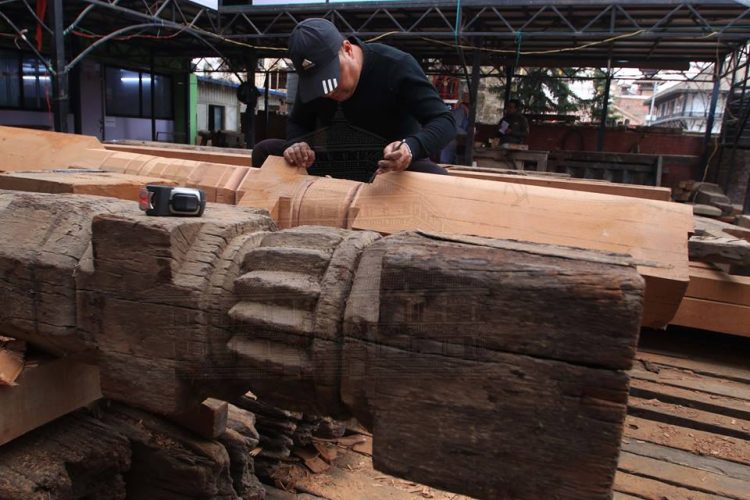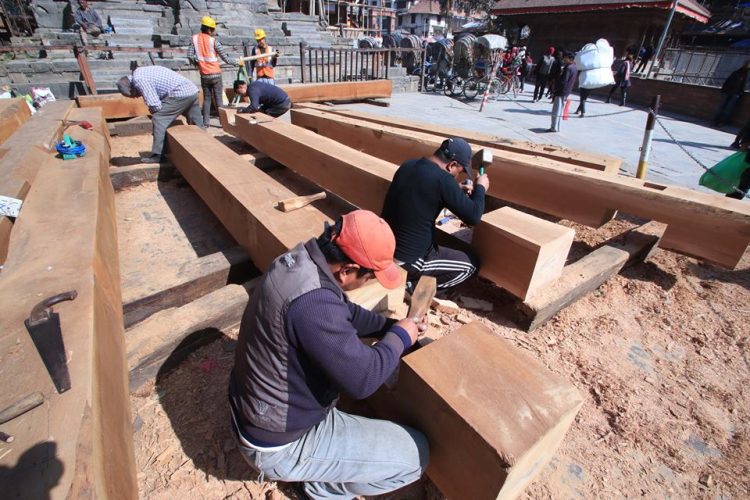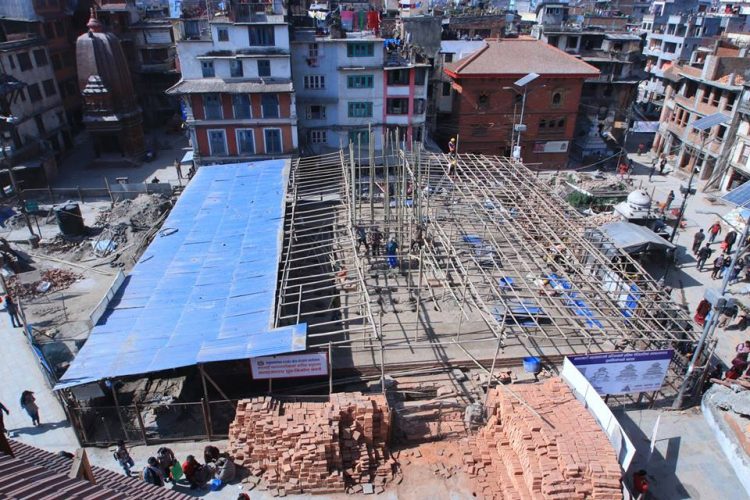Progress report on Kasthamandap reconstruction
Injina Panthi / March 8, 2019

All photos: courtesy of Kasthmandap Reconstruction Committee.
Nepal government’s annual policy and program 2018/2019 states that the cultural heritages destroyed by April 2015 earthquakes will be reconstructed within three years. The Kasthamandap Reconstruction Committee, established in May 2018 to rebuild the Kasthamandap Temple at Kathmandu Durbar Square, aims to finish the work ahead of schedule.
South Asia Check this week visited the president of the reconstruction committee Rajesh Shakya for updates of reconstruction. Here is the excerpt of talk:
Major activities in the last 11 months [since May 2018]
May1, 2018 – Kasthamandap Reconstruction Committee (KRC) formed.
May 6, 2018 – Division of work and formation of working group that includes expert group, advisors’ group and conservation architects’ group
May 10-12, 2018 – Collected the wooden debris of the Kasthamandap Temple.
May 14, 2018 – Performed Kshyama Puja (a forgiveness ritual).
June 12, 2018 – MoU signed between Kathmandu Metropolitan City (KMC) and Kasthamandap Reconstruction Committee. KMC provides a grant of Rs 5 million for starting the reconstruction work.
July17, 2018 –Technical Office set up
August 28, 2018 – Cleanup of the temple debris starts
October 13, 2018 – KMC provides another grant of Rs 50 million.
December 13, 2018 – Department of Archeology approves the blueprint of Kasthamandap.
November 8, 2018 – Karya Siddhi Puja [praying to the deities for success at work] performed, reconstruction work begins.
February 10, 2019 – Sankalpa Puja [commitment ritual] performed on the occasion of Shree Panchami and four pillars were erected. During the month, 16 wooden pillars were erected and four wooden beams were installed.
By June -July 2019 – Target to complete the first floor
Cost estimate and expenditures
According to committee chair Shakya, approximate funds required for the reconstruction of the temple have yet to be decided. But according to the 55th annual report of the Auditor General 2074 BS, the Kathmandu Metropolitan City had on August 14, 2016, approved a cost estimate of Rs 198.811 million prepared by the Department of Archeology (DoA) for the reconstruction of Kasthamandap. Later the cost was revised down to Rs 71.326 million by excluding the cost of timber after the Timber Corporation of Nepal decided to provide within five years 800,000 cubic feet of timber required for the reconstruction of the heritage sites at Kathmandu Durbar Square.
According to the quarterly expense report published in mid-January 2019, Rs 9.1 million was spent and of this Rs 2.7 million involved advanced payments. By mid-April, another quarterly report is to be published.
Source of funds
The committee hasn’t sought support from donor agencies as it plans to rebuild the temple through domestic resources and traditional expertise. Kathmandu mayor Bidya Sundar Malla has expressed commitment that the Kathmandu Metropolitan City itself will fund the reconstruction.
Experts
All the experts and archeologists involved in Kasthamandap reconstruction are Nepali.
Workers
Most of the artisans are from Bhaktapur and they are led by woodcraftsman Laxmi Bhakta Rajchala. Unskilled workers are from outside Kathmandu.
Sources of construction materials
According to the DoA, Kasthamandap reconstruction will require 1,758 cubic feet of best quality sal timber. The timber needed for pillars and beams was brought from Bardibas of Mahottari district. The rest of the timber was brought from Hetauda, Rautahat and Kailali. For the soil needed for reconstruction, samples from various places of Kathmandu were tested and the soil from Tahachal area proved to be ideal and it is being used.
Coordination with other agencies
The committee has been working in close coordination with other agencies including the National Reconstruction Authority and the Department of Archeology.


This material is copyrighted but may be used for any purpose by giving due credit to southasiacheck.org.
Comments
Latest Stories
- In Public Interest Covid-19 cases are low, but that’s not an excuse to avoid vaccination
- In Public Interest What is BF.7, the sub-variant that has the world by its grip?
- In Public Interest Threat of a new Covid-19 wave looms large amid vaccine shortage in Nepal
- In Public Interest As cases decline, Covid-19 test centres in Kathmandu are desolate lot
- In Public Interest Dengue test fee disparity has patients wondering if they’re being cheated
- In Public Interest As dengue rages on, confusion galore about what it is and what its symptoms are. Here’s what you need to know
In Public Interest
 Covid-19 cases are low, but that’s not an excuse to avoid vaccination
The Pfizer-BioNTech bivalent vaccines authorised by the Nepal Government provide better protection a...
Read More
Covid-19 cases are low, but that’s not an excuse to avoid vaccination
The Pfizer-BioNTech bivalent vaccines authorised by the Nepal Government provide better protection a...
Read More
- What is BF.7, the sub-variant that has the world by its grip?
- Threat of a new Covid-19 wave looms large amid vaccine shortage in Nepal
- As cases decline, Covid-19 test centres in Kathmandu are desolate lot
- Dengue test fee disparity has patients wondering if they’re being cheated
- As dengue rages on, confusion galore about what it is and what its symptoms are. Here’s what you need to know